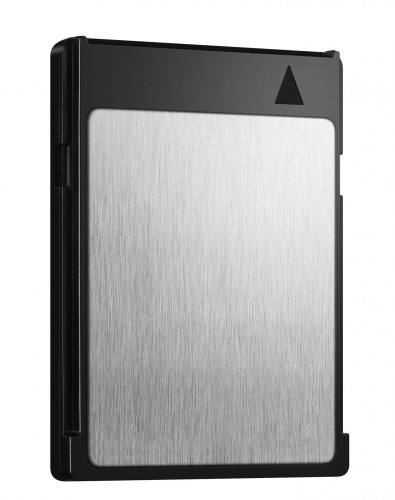
The CompactFlash Association announced a new XQD standard for CF cards. The new standard is based on the PCIe standard and should offer 125MB/s data transfer speeds out of the gate – with much faster possibilities later down the line.
Speed isn’t the only thing that has changed though. The XQD cards (I’m guessing that’s what we’ll call them… but couldn’t we have stuck to only 2 letters?) are a completely different physical format, which means they won’t work in any current camera.
This is likely a move in response to the overwhelming growth of the SD card format, which has increased in capacity and speed in recent years – to the point that nearly every camera and phone on the market uses some form of SD cards now. While the fastest SD cards out there right now aren’t on par with the fastest CF cards, they’re close. So close, in fact, all but the most demanding users with the latest gear could tell the difference. In a lot of cases, the camera’s buffer is can’t take full advantage of the SD cards’ write speed. (See Demystifying SD Cards)
While the top-end pro cameras still use CF cards (e.g., Canon 1D X, Nikon D3s, Canon XF305), I wouldn’t have been very confident that the next generation of top-end cameras would choose CF over SD again. So, this move to the XQD standard may be a play by the CF Association to retain some sort of dominance in the high end market, while trying to grab a foothold back into the lower end DSLR cameras that it once controlled.
I haven’t found an image of the XQD cards’ interface; however, I have to assume that they have done away with the exposed pin design that was the bane of anyone who ever had the misfortune of bending one of those pins.
I should have more details on this format at CES 2012 next month and maybe get a peek at a sample or two – not that I’ll have a camera to put it in though.
See the full (yet slim) press release below.
Cupertino, California – Dec. 7th, 2011 – The CompactFlash Association (CFA) is pleased to announce the release of the XQD specification as a new high performance memory card. This XQD specification is based on the PCI Express® specification, which provides a solid base for future performance scaling.
The CFA has adopted a new card specification with exciting performance and storage capabilities.
The key features of the XQD format include:
Optimized form-factor
- Dimensions : 38.5 x 29.8 x 3.8mm
- Durable & Robust
Scalable High Performance Interface
- PCI Express: 2.5Gbps today and 5Gbps Future
Actual Write Speeds
- Target 125MB/sec and Higher
To distinguish the new memory card format, an XQD compatibility mark has been created as shown below.
 XQD Compatibility Mark
XQD Compatibility Mark“The XQD format will enable further evolution of hardware and imaging applications, and widen the memory card options available to CompactFlash users such as professional photographers,” said Mr. Shigeto Kanda of Canon, chairman of the board, CFA.
XQD cards will be shown at the CompactFlash Association booth at CP+ 2012, February 9-12 in Yokohama, Japan.
Licensing for CFA members will start in early 2012. Please contact the CompactFlash office for more information.
The CFA (logo), CF (logo), CF+ and CFast are trademarks of the CFA and are licensed royalty free to its members. The CFA is a licensee of the CompactFlash® and XQD trademarks and in turn will license it royalty free to its members.


It’s good that they are updating the standard to something more modern, but the big question is what price point are they shooting for? With the announcement of 167 MB/s CF cards coming soon they are going to have to make the XQD pricing closer to SD cards in pricing to try and convince people to switch. Plus it’ll help if there was a camera that could use it as well.
Whatever happened to that other CF standard that was announced earlier in the year? Is this a replacement for that or are they seriously looking at pushing two new standards?
Are you talking about CFast? It seems that it never really caught on – even with some real promising speed outlook.
Yup that was it. The speed bump looked great. I wonder why they killed it off and why it didn’t catch on at all.
Fail.